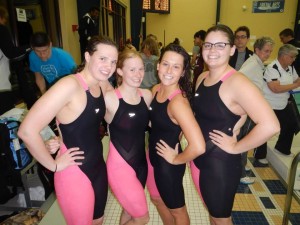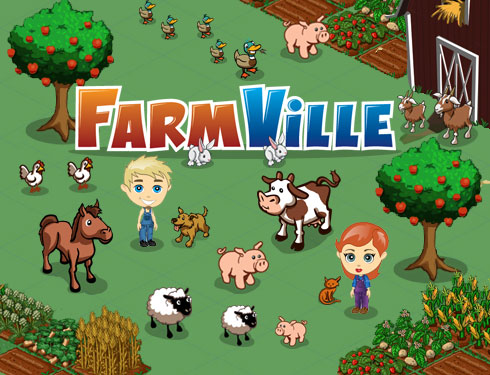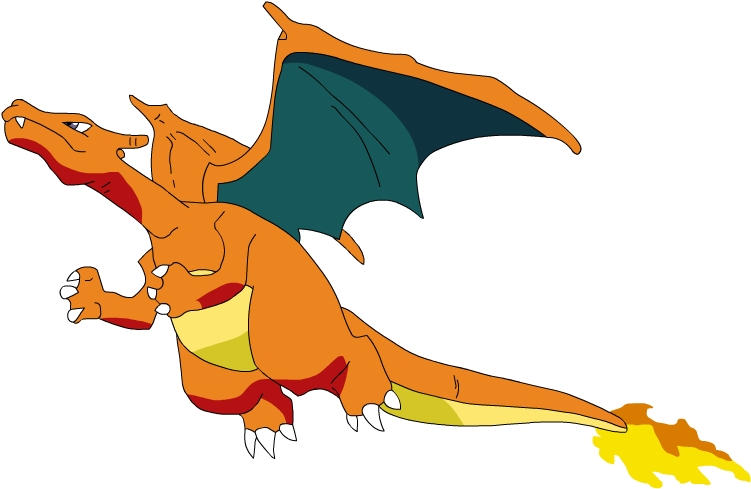 The four of us stand in a group of athletic college women in warm-up sweats and jackets pulled over their racing swimsuits. A blue curtain separates us from the rest of the pool, creating a makeshift “ready room” in which we can stretch, strategize, and mentally prepare for the race ahead.
The four of us stand in a group of athletic college women in warm-up sweats and jackets pulled over their racing swimsuits. A blue curtain separates us from the rest of the pool, creating a makeshift “ready room” in which we can stretch, strategize, and mentally prepare for the race ahead.
“Okay guys, we just need a solid race to start off the night,” says our relay freestyler, Emma, fidgeting with the strap on her goggles. “If we do a good job, the rest of the races will follow.”
“Yeah, we definitely can’t screw it up,” says our butterflier, Jaimie, pushing her long strawberry-blonde hair into a black Mustang insignia swim cap. “Our goal here is to set the tone.”
In a chair to my right sits a Luther swimmer who has already established herself as the best swimmer at the meet. Even when relaxed, I can see the careful definition of her biceps. She will go on to be the NCAA Division III National Champion in the 200 backstroke, but right now, she is getting ready to swim the same leg of the relay as I am, just two lanes away.
I take a deep breath.
I feel a hand on my shoulder. Jaimie looks at me and smiles.
“It’s time.”
I can feel the rough concrete on my feet as I walk in a line with all the other swimmers along the side of the eight lane indoor pool. Sound bounces endlessly off the walls, a mixture of cheering and an upbeat pump-up song, Kanye West’s “All of the Lights.”
The tension is palpable. The pool itself is silent and pristinely clear, a sheet of pure glass just waiting to be broken. It’s time for the first final of the second night of the 2014 Liberal Arts Swimming Championships: the women’s 200 yard medley relay.
My goggles press into my eye sockets atop a black, latex Mustang logo swim cap, scrupulously tightened to the point that no water can possibly leak in. My brand new Speedo LZR Racer II technical swim suit puts an extra spring in my step, the tightly-fitting fabric coming all the way to the tops of my knees and making my legs spring together with every stride. Earlier, it took 15 minutes and some help from one of my relay team members to help pull the drag-reducing, muscle compressing suit all the way on. I try and walk with an expression of pure concentration to hide my nervousness.
I can feel my teammates close on my heels. We walk in the order of the relay: as the backstroker, I’m first; then comes our breaststroker, a freshman standout; then the butterflier, my roommate and best friend; and our superstar freestyler, last year’s champion in the 100 distance. Each of us is prepared to swim an all-out sprint 50 yards of our stroke. All we have is one start, one turn, and one finish to make or break our leg of the race.
We make our way to our assigned lane number three. The team with the fastest time from prelims that morning swims in four, the second fastest in five, the third in three, and so on until the slowest teams are on the outside lanes. While we know that we will have the chance to swim this race again at Nationals, our “conference” race is what really counts. Since we are the only swim team in our NAIA GPAC conference, we are at Liberal Arts Championships to prove to the group of NCAA Division II and III teams that we have what it takes.
I know that to pull my weight on our team, I’m going to have to break 30 seconds for the first time in my twelve year swimming career. My teammates are all much better at the 50 yard distance than I am, and I feel pressured to prove myself.
The four of us strip off our jackets and sweats and throw them into a pile behind lane three. Jaimie catches my eye and breaks into a nervous smile. Here goes. I smile back, take a deep breath, and walk to the edge of the pool.
In the background, I can hear the receding staccato notes of our team’s cheer from the opposite end.
“MUSTANG RELAY!” clap clap clap-clap-clap.
To my left and right are two girls much taller and more muscular than I. They both have the signature broad shoulders and narrow waists, the marks of a swimmer. They jump and shake their limbs to get the blood rushing.
I put on my noseplug, a piece of equipment that the younger me would have foregone. However, Missy Franklin’s 2012 Olympic performance motivated me to emulate her backstroke choices right down to smallest details.
A long whistle blast follows two short ones: the signal to be ready.
I extend my arms, lock my elbows, and clap above my head. Our breakstroker, Mikki, does the same, followed by our butterflier and freestyler. It’s our relay team’s version of “the wave.”
I turn around for a second and see Mikki beaming, having invented our clap wave herself. I smile and regain my composure.
“This is the A final of the 200 Yard Medley Relay.”
One long whistle blast. I step into the pool, letting myself submerge a couple of feet under. When I break the surface, I turn around to face my teammates behind the lane, place my feet on the wall, and grab the backstroke starting bar with both hands.
This is the moment. The room goes silent for the start of the race.
“Take your mark.”
I flex my arms to bring my body up into the starting position. Every muscle in my body is tense, a spring itching to decompress.
A tone rings out from across the pool like a single-note metronome.
I throw my arms above my head, arch my back, and push off the wall with my feet into a back-dive. My palms are face up, one on top of the other. The sides of my biceps compress the sides of my head, and my elbows are locked into a streamline position. I am deep under, and I can see four feet of water above my head, ending at a smooth glassy surface.
This is my favorite part of the race. Underwater and lying on my back, I can’t see my competitors in the adjacent lanes. I have more momentum than I ever will have in the race, and for a brief fraction of a second, I hold my muscles tight and let my earlier exertion propel me forward. It’s meditative and peaceful.
But the moment doesn’t last, and I feel myself start to slow down. I break into a fast rhythmic dolphin kick, a sine wave originating with a flex of the abdominals and ending with a powerful simultaneous upstroke of my feet. I can see the surface quickly approaching, and after six kicks, I pull one arm down out of the streamline position, in preparation to break the surface.
The first thing to break is my hands. Soon after, the rest of my body follows, but I haven’t missed a beat. My legs have transitioned to an alternating flutter kick and my arms begin the windmill-like backstroke motion. With every armstroke, my body turns almost completely onto its side, a rotating motion with my stationary head as the axis. I take a deep breath.
Six strokes and I see the backstroke flags overhead, warning me that the wall is quickly approaching. I take one normal stroke and use the next one to turn over onto my stomach. The timing here is key. Hit the wall too close, and I’ll waste time trying to untangle and decompress my legs at the push-off. Hit the wall from too far away, and I’ll lose the vital momentum boost that comes from the turn.
Lying on my stomach now, I let my final stroke lead me into a high-speed summersault. As I flip over, I catch a glance of my competitor, the Luther standout in lane four; I see the tips of her feet as she pushes off the wall. She’s ahead.
Repositioned on my back, I extend my arms into streamline position above my head, and concentrate all of the energy in my body into the push off. I jump off the wall and look up again to feet of water above my face.
Streamline. Dolphin kick. Break the surface. Breathe.
This is the final stretch. Fifteen yards to go. Out of the corner of my eye, I sense that the lane two competitor and I are neck-and-neck. I increase my kickrate and stroke my arms until they feel like they’re flailing. I know that my main strength is in my kick, so I alternate my legs up and down until my quadriceps burn.
The end set of backstroke flags pass over my head. Here, I need to have the perfect finish. If I slow down or take a half-stroke into the wall, I’ll cause my teammate to false start, disqualifying our team from the race.
On the fourth stroke from the flags, I dive back and my hand hits the wall. Looking up from underwater, I can see a human-shaped blur fly over my head as Mikki, our freshman standout breaststroker, relay starts off the block.
I turn to grab the wall, and my legs seize up. I can hardly get enough oxygen. I scramble to climb out of the pool quickly, so as not to obstruct my teammate’s finish.
I’m out of the pool, hot, dripping, and nearly doubled over trying to catch my breath. I look up at the scoreboard for my split.
29. 95. Personal best time. I broke 30.
My face breaks out into a smile. I feel our freestyler pat me on the back.
“Nice.”
Still smiling, I finally catch my breath and throw it all into a cheer for my breaststroking teammate.
“C’MON MIKKI! YOU’VE GOT IT!”
I fall into my favorite breaststroke cheer, a quick “HUP” every time she breaks the surface. And before I’ve been cheering for long, she hits the wall, and my butterflying best friend windmills her arms into a relay start.
31.97. Personal best time.
As soon as she climbs out of the water, I clap our breaststroker on the back, and soon we’re both jumping up and down cheering.
“GO JAIMIE GO!”
She finishes to the wall. 28.27. Personal best time.
We’ve fallen back. It’s looking like a solid fifth place.
However, we all know that our freestyler is our secret weapon. Emma is the type of swimmer who looks like she isn’t even trying. Actually, a lot of the best swimmers look like that. Each stroke is layered with such a huge amount of power that she seems to glide through the water without a second thought.
She closes in on the fourth place team. McMurry in lane six. She seems to glide right ahead of the McMurry swimmer, who thrashes in the water expending everything she has.
Mikki is leaning by the edge, her knuckles and face turning white as she yells. Jaimie and I are jumping and yelling. Across the pool, I can see my coach and teammates clenching their fists and swinging their arms screaming at the tops of their lungs.
Her hand touches the wall. 1:54.69. Our personal best time. One-tenth of a second away from the school record. Fourth place. The perfect start to the night of finals.






